
What types of tea are there?
钱多福Share
Whether it is loose leaf tea or tea bags, they are all a type of tea. There are many types of tea.
All true teas come from the Camellia sinensis tea plant, which is the source of various tea types.
The following are some common types of tea:
White Tea – The least processed of all the teas. The leaves are simply plucked and allowed to wither and dry. It has a delicate flavor.
Benefits of white tea: rich in antioxidants, helps anti-aging and promotes heart health.
Examples: Silver Needle, White Peony
Green Tea – The leaves are quickly steamed or pan-fired to prevent oxidation, preserving the green color and fresh, grassy flavor. Japanese and Chinese green teas differ in their processing techniques, enhancing certain characteristics and flavors. Matcha tea is a vibrant and flavorful Japanese green tea powder known for its unique preparation method and cultural significance.
Benefits of green tea: improves brain function, promotes metabolism, and helps lose weight.
Examples: Sencha, Matcha, Longjing (Dragon Well)
Oolong Tea – A partially fermented tea, falling somewhere between green and black tea. It is situated between black and green teas in terms of oxidation. Oolong tea is a partially oxidized tea, highlighting its unique brewing characteristics and regional production methods. It has a complex flavor profile, ranging from floral to rich and roasted.
Benefits of oolong tea: accelerates fat burning, improves heart health and skin condition.
Examples: Tie Guan Yin, Da Hong Pao, Phoenix Dan Cong (like your Phoenix Single Cluster)
Black Tea – Fully fermented tea, known for its bold and robust flavor. Black teas are fully oxidized, yielding a robust flavor and a dark brew, with many common types like English Breakfast and Darjeelings. The oxidation process darkens the leaves and develops deep, malty or fruity notes.
Benefits of black tea: refreshes the mind, promotes digestion, and helps improve cardiovascular health.
Examples: Assam, Darjeeling, Earl Grey, Ceylon
Pu-erh Tea – A fermented and aged tea from China, often compressed into cakes or bricks. It has an earthy, sometimes musty flavor, with aging improving the taste over time.
Benefits of Pu’er tea: promotes digestion, detoxification, and helps lower cholesterol.
Examples: Sheng (raw) Pu-erh, Shou (ripe) Pu-erh
Herbal Tea – Technically not “true” tea (since it doesn’t come from the Camellia sinensis plant), herbal teas are made from infusions of herbs, flowers, fruits, or spices.
Benefits of herbal tea: helps relax, relieves stress, improves digestion and sleep quality.
Examples: Chamomile, Peppermint, Rooibos, Hibiscus
Each type can have many sub-varieties and regional differences, so there’s a vast array of flavors to explore!
In Chinese tea, there are usually six main types of tea.
What are the six major types of tea in China?
White tea, yellow tea, green tea, oolong tea, black tea, and dark tea (Pu'er tea) are collectively known as the six major types of tea in China.
Each type of tea is made through specific processes such as steaming, steeping, and oxidation. These methods highlight the unique characteristics and flavors of each tea variety.
What does China's six major teas taste like?
The six major types of tea in China include green tea, black tea, oolong tea, white tea, yellow tea and dark tea (Pu'er tea).
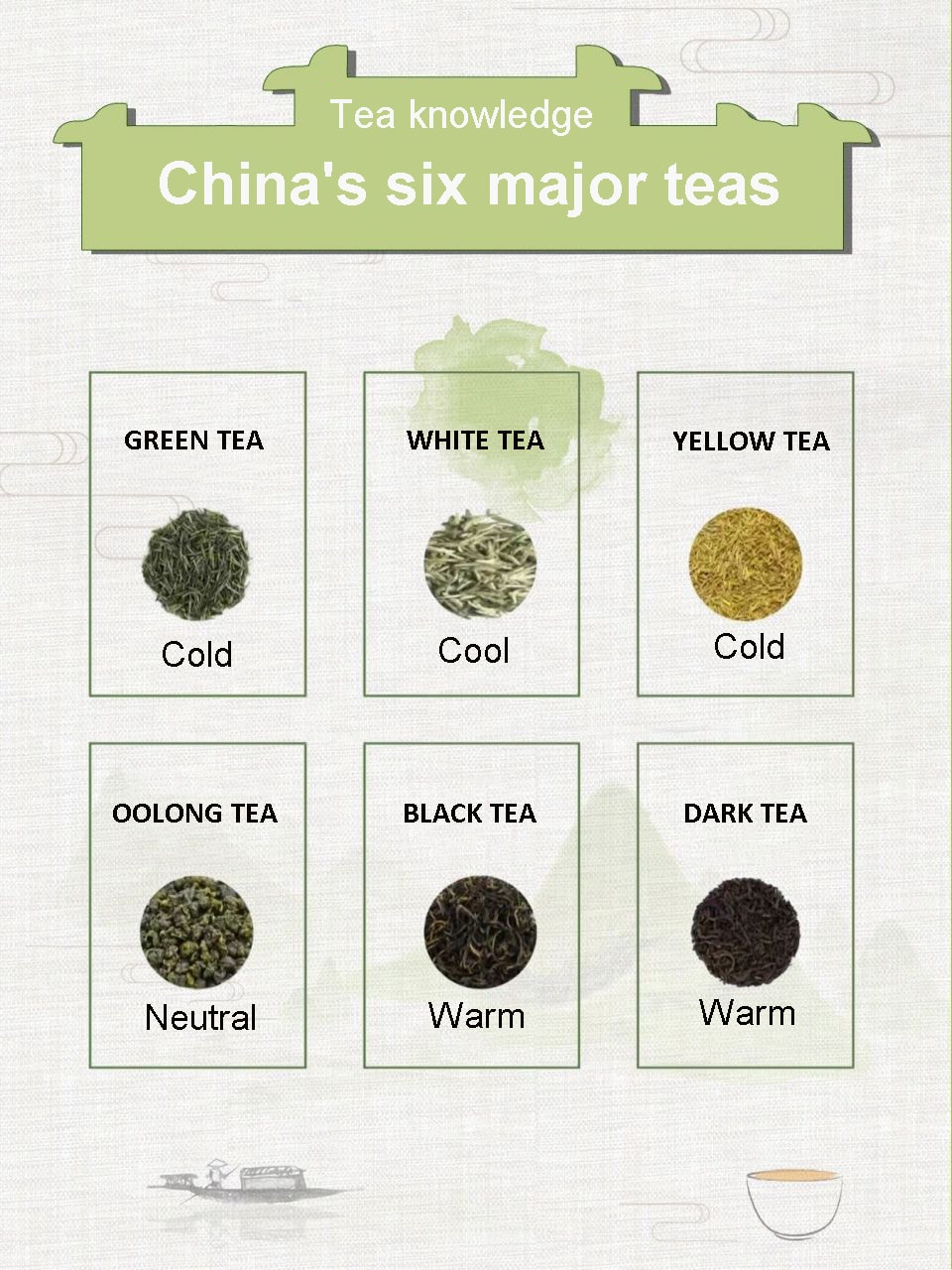
Green tea is refreshing, black tea is strong and mellow, oolong tea is rich in aroma, white tea is light and sweet, yellow tea has a mild taste, and Pu’er tea is unique and becomes more mellow as it ages. Each type of tea has its own unique production process and flavor, reflecting the diversity of Chinese tea culture. All these teas come from the Camellia sinensis tea plant, highlighting its significance in tea production.
What are the ingredients of tea?And the health benefits of tea
There are many ingredients in tea
It is important to understand the ingredients of tea, because the ingredients of tea are related to our health. Choosing the right tea according to our physical condition can make us healthy.
The main components of tea include:
Caffeine
boosts alertness and energy.
Polyphenols
such as catechins and theaflavins, which have antioxidant and anti-inflammatory properties.
Amino acids
such as L-theanine, which aids relaxation and focus.
Tannins
which impart astringency and aid digestion.
Vitamins
such as vitamin C and B vitamins, which boost immunity and support energy metabolism.
Minerals
such as potassium, calcium, and fluoride, which support heart and bone health.
And essential oils
which provide aroma and relaxation.
These components work together to give tea its rich flavor and many health benefits.
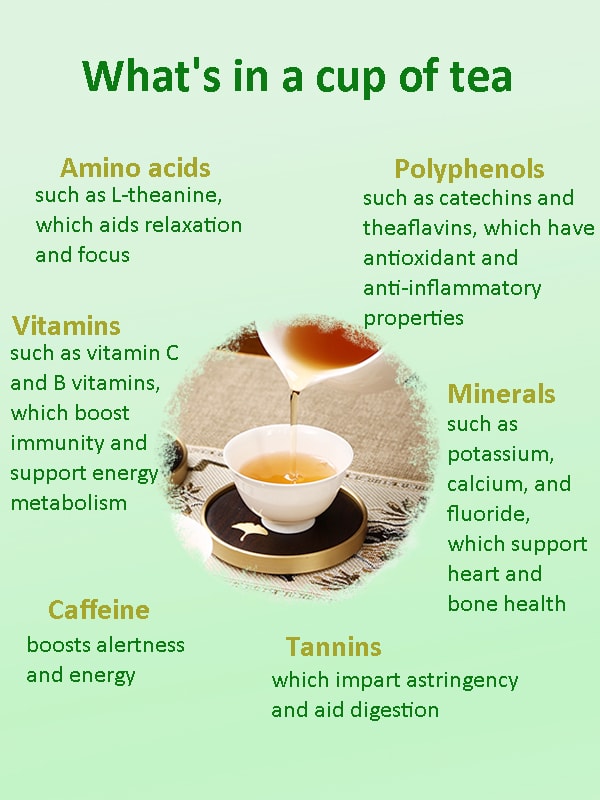
Loose leaf tea or tea bags: which is better?
Both loose leaf tea and tea bags have their advantages and disadvantages, depending on what you're looking for in terms of convenience, flavor, and quality. Here's a comparison to help you decide which might be better for you:
Loose Leaf Tea
Pros:
- Higher Quality: Loose leaf tea generally contains whole or larger tea leaves, which preserve the delicate flavors and aromatic compounds better. This often results in a more flavorful and aromatic brew.
- More Control: You can control the amount of tea you use, the steeping time, and the water temperature, leading to a more customized cup of tea.
- More Variety: Loose leaf tea often comes in a wider range of varieties and blends, including rare and high-quality teas that are not typically available in tea bags.
- Eco-Friendly: Loose leaf tea doesn’t require individual bags, reducing packaging waste, and many companies offer biodegradable or reusable options for steeping.
Cons:
- Requires More Effort: You need a tea infuser, strainer, or teapot to brew loose leaf tea, making it slightly more time-consuming and less convenient.
- Storage: Loose leaf tea needs proper storage to keep it fresh (airtight containers), and it may take up more space than tea bags.
- Cleanup: The tea leaves can be messy and harder to dispose of than the simple disposal of a tea bag.
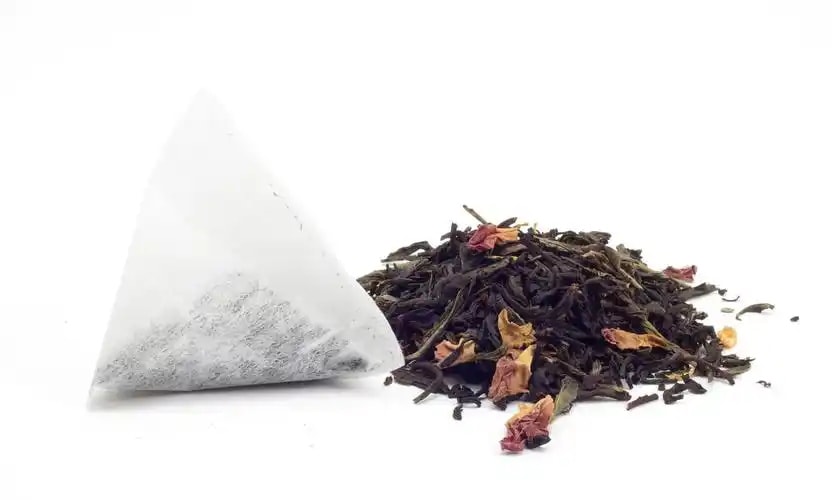
Tea Bags
Pros:
- Convenience: Tea bags are quick, easy, and mess-free. They’re perfect for people who are always on the go or want a fast, no-fuss cup of tea.
- Portability: Tea bags are easy to store and take with you, making them ideal for travel or work.
- Less Cleanup: With tea bags, there’s no need to worry about cleaning tea infusers or strainers—just toss the bag after use.
Cons:
- Lower Quality: Many tea bags contain smaller, broken tea leaves or tea dust, which can lead to a less flavorful and aromatic cup of tea compared to loose leaf.
- Limited Control: With tea bags, you have less control over the amount of tea and steeping time. The tea in the bag may not allow for optimal flavor extraction.
- Environmental Impact: Traditional tea bags are often made from paper or plastic, and while some brands now use biodegradable bags, many still contain synthetic materials like polypropylene, which are not eco-friendly.
Which is Better?
- For Flavor and Quality: Loose leaf tea is generally better, as it offers a richer, more complex flavor due to the larger, more intact tea leaves.
- For Convenience and Portability: Tea bags are the better option if you're looking for ease of use, quick brewing, and portability.
- For Environmental Impact: Loose leaf tea is usually the more eco-friendly option, although some tea bag brands are now making biodegradable or compostable bags.

In summary, if you're a tea connoisseur who values flavor and quality, loose leaf tea is likely the better choice. If you're looking for convenience and speed, tea bags might be more suitable.
If you want to taste delicious tea, you usually need to use some special tea sets to brew tea, so that the aroma and taste of the tea can be truly brought out.
What tea sets are needed to make tea?
Tea set needed for making loose leaf tea
The main tea sets needed for brewing loose leaf tea are a kettle, a teapot (or covered bowl), a fairness cup, a tea tasting cup, and some auxiliary tea sets. Here is a detailed explanation:
- Kettle: used to boil water, which is the first step in brewing tea, to ensure that the water temperature is suitable for the loose leaf tea to be brewed.
- Teapot or covered bowl: a teapot (such as a purple clay pot, porcelain pot, glass pot) or a covered bowl is the core tool for brewing loose leaf tea, which allows the tea leaves to fully expand and release the tea fragrance.
- Fairness cup: used to hold and distribute tea soup, ensuring that the concentration and taste of each cup of tea soup are consistent, so that every tea drinker can enjoy the same taste.
- Tea cup: a small cup used for drinking tea, you can taste the tea fragrance and appreciate the color of the tea soup.
- Auxiliary tea sets:
- Tea cup: used to appreciate tea and measure the amount of tea leaves.
- Teaspoon: Used to push tea leaves from the tea spoon into the teapot.
- Tea needle: If the spout of the teapot is easily blocked, the tea needle can be used to unclog the spout.
- Tea strainer: Placed at the mouth of the fair cup when pouring tea to prevent the tiny tea leaves in the tea soup from spilling out of the pot, keeping the tea soup pure.
- Tea tray: Used to hold teapots, teacups and other tea sets to keep the tea table clean.
- Tea towel: Used to dry the teapot or wipe water marks on the table.
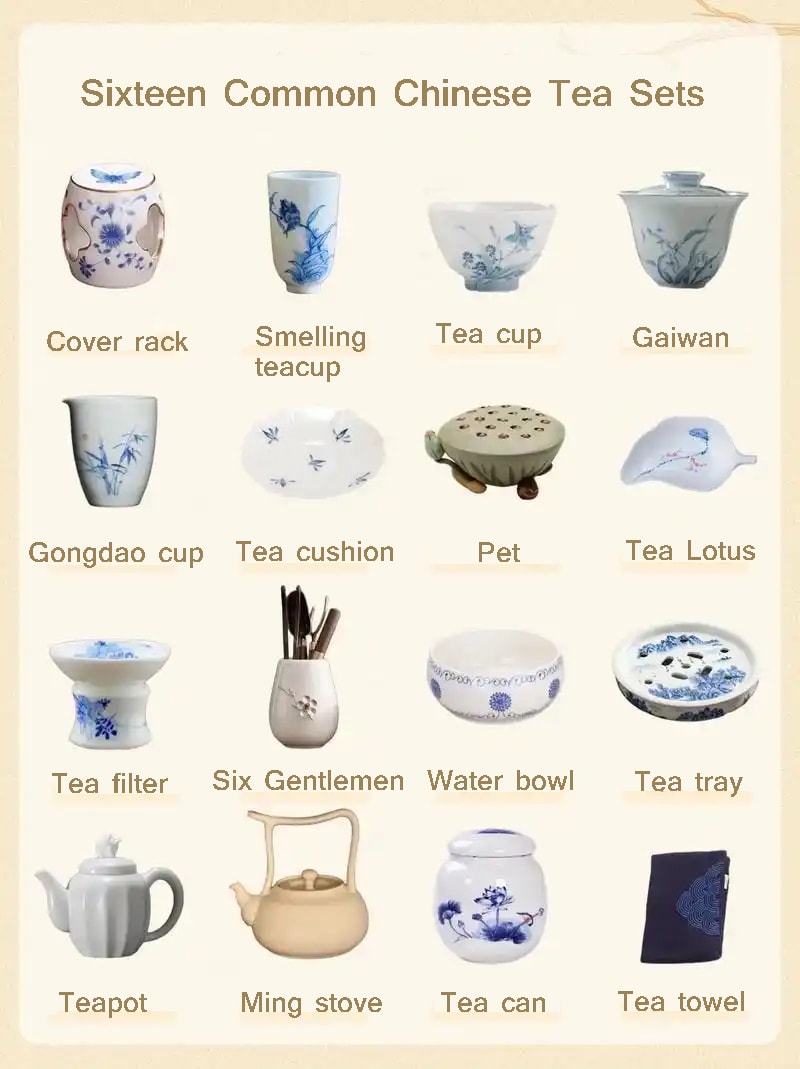
Tea brewing is an art, called tea art, especially Chaozhou Gongfu tea art, which is an important part of Chinese tea culture. It integrates spirit, etiquette, brewing skills, tea inspection art and quality evaluation into a complete tea ceremony.
Chinese Tea
Chaozhou Gongfu Tea
Chaozhou Gongfu tea is a shining pearl in Chinese tea culture, famous for its unique tea sets and tea brewing skills.
Chaozhou Gongfu tea pays great attention to the selection and use of tea sets in the process of brewing tea. Among them, the four essential tea sets include:
- Yushu Wei (sand pot or tea pot): It is made of sand pottery and is an excellent choice for boiling water. It has excellent heat preservation effect and can keep the tea soup at the best temperature.
- Chaoshan stove (wind stove): A special stove for boiling water, often using black olive charcoal, and using a white goose feather fan to fan the fire, adding fun and ritual to brewing tea.
- Mengchen jar (small pottery pot): a teapot for brewing tea. In the early days, Yixing purple clay teapots were the main ones. They were named after Hui Mengchen, a master teapot maker in the late Ming and early Qing dynasties. They are particularly suitable for brewing oolong tea and can gather tea fragrance very well.
- Ruoshen Ou (Ruoshen cup or Baiyuling): a tea tasting cup with a small shape and jade-like white color, a flat bottom and a wide mouth, and a texture as thin as paper. It can perfectly set off the color of the tea soup and has the characteristics of being small, shallow, thin, and white.
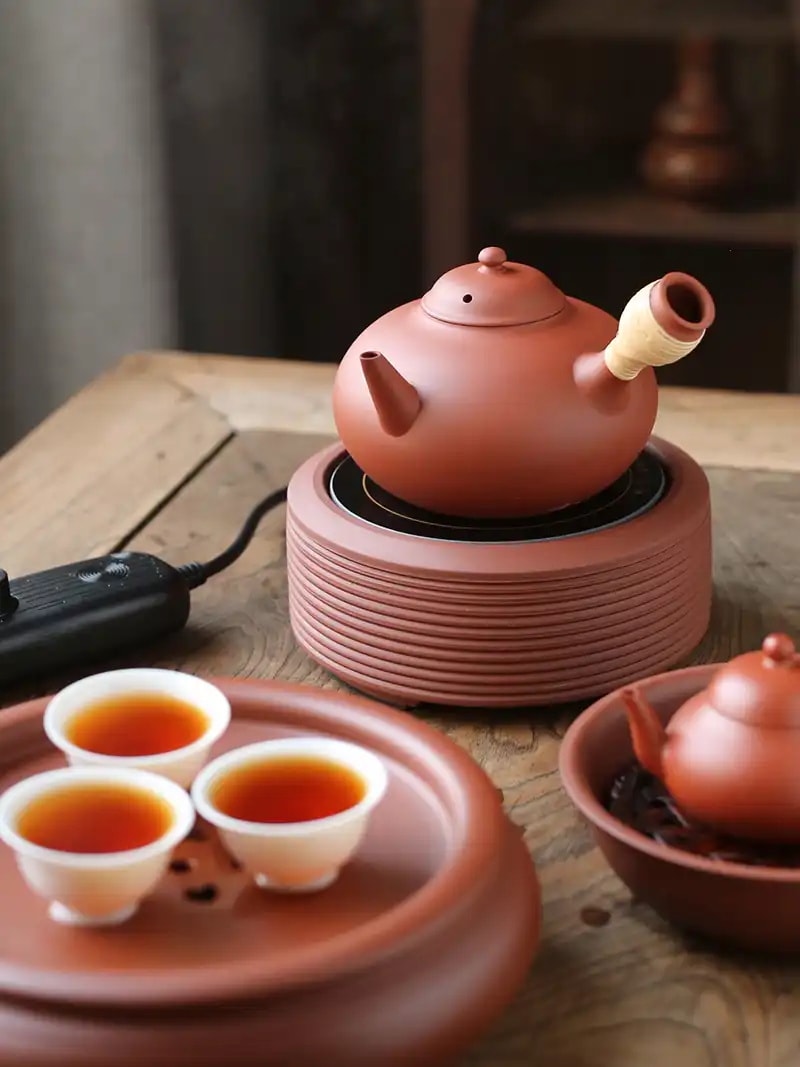
In addition, Chaozhou Gongfu tea also pays attention to the process and ritual of brewing tea. From boiling water, warming the cup, placing tea, brewing, scraping foam, pouring the pot, scalding the cup, dividing tea to serving tea, each step has its own unique details and skills, reflecting the Chaozhou people's love for tea and their unique understanding of tea culture.









